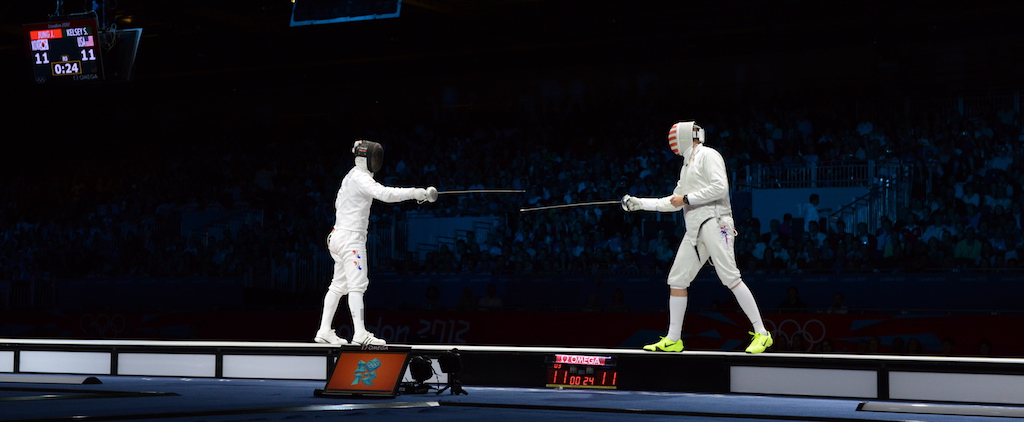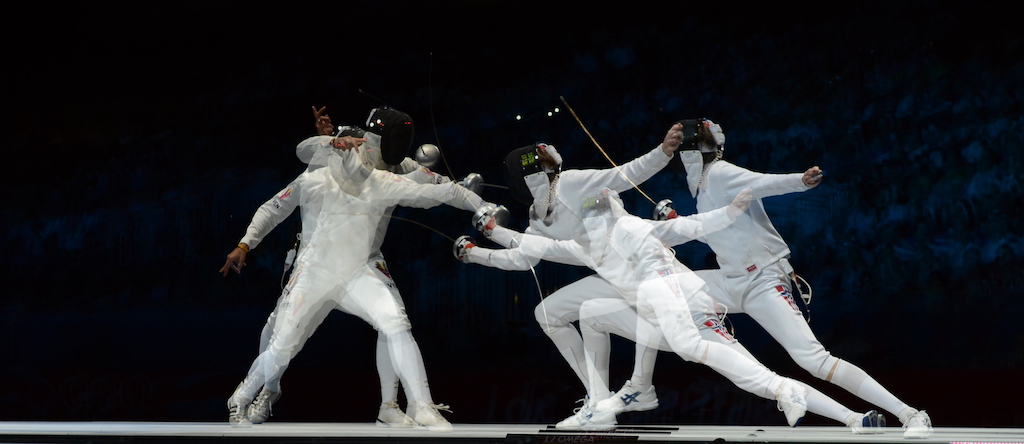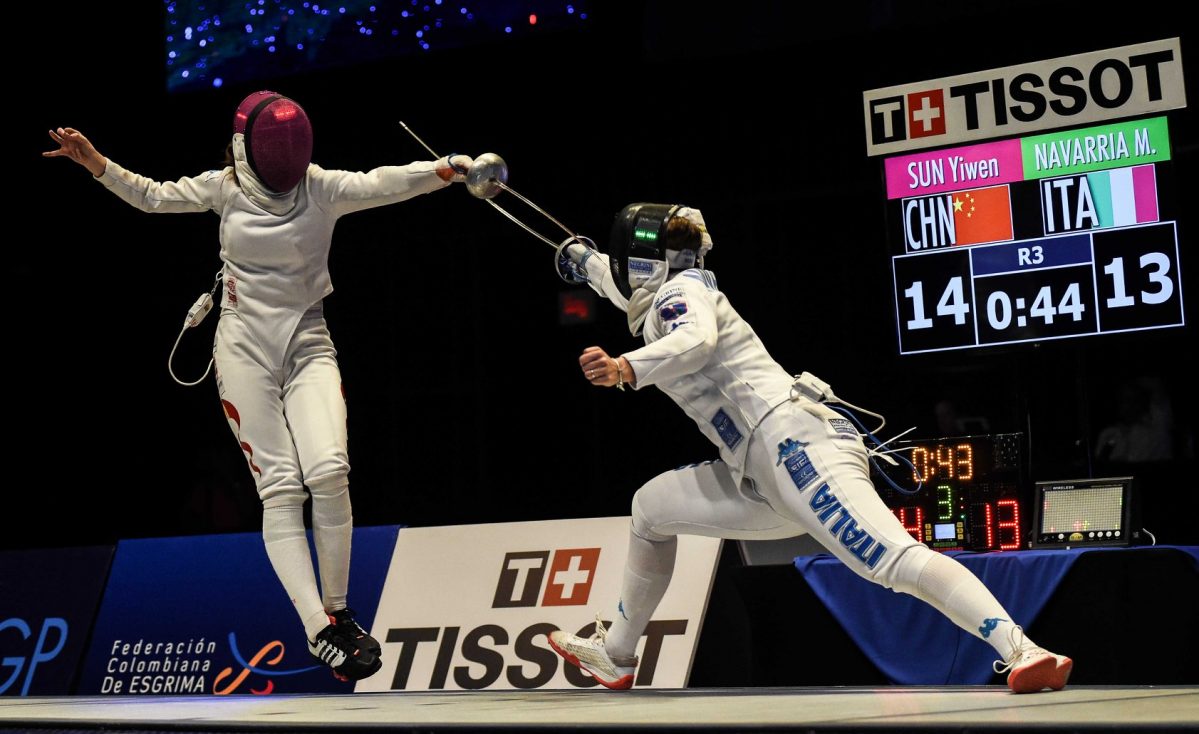An Alternative To The Proposed Changes To Noncombativity by Kevin O’Neill
The FIE has recently proposed changes in the penalties to be applied in case of non-combativity (NC). The justification for this is a dislike, especially in Olympic circles, of extremely passive fencing, particularly in épée. The new penalty is a yellow card for both fencers, progressing to disqualification of both fencers for the second instance. The rule change proposal appears as Urgent Letter #2 under the FIE Congress agenda.
The problem of non combativity might put fencing in a dangerous position in the next Olympic Games if not efficiently resolved. The General Secretary has asked to propose a change in the rules that could be urgently approved in the next Comex.
FIE Urgent Letter
Let’s accept for a moment that “overly passive fencing” (which is to say, fencing without scoring for one minute) is unattractive to Olympic officials and viewers. Is this rule a good way to combat that tactic? I propose that it is not, and that there is a better, more elegant rule change possible, one that has already been demonstrated to produce more active, more aggressive épée.
But before I talk about that, let me address my fellow épée fencers: Ladies, gentlemen, there’s nothing wrong with tweaking the rules of a game. Honestly, nothing. Games change rules all the time in order to produce desirable gameplay. Basketball, for example, has had a multitude of rules changes over the years.
Each rule change was in response to a tactic or style of play the officiating body found produced undesired play. Ok, so our officiating body has decided they want to get rid of low scoring épée bouts. That’s a perfectly normal tweak to the rules, to complain about it is naïve.

The proposed rule change is not a very good remedy.
Let’s examine the root of low-scoring, passive épée: Each fencer is being very careful, often because the score is tied or the fencer is playing for a tie. If one fencer is losing we rarely see passive fencing, since the losing fencer must push to catch up. But when the score is tied we often see very careful, very tactical fencing, which the FIE has made clear is too slow.
The problem here is symmetry. Each fencer is in exactly the same situation when the score is tied. Each, correctly, thinks he has to be very careful. Each, correctly, thinks that it’s better to wait than to make a rash, ill-advised attack.
So the FIE proposes a penalty that is… symmetric. Each fencer gets a yellow card.
Proposed Rule: Penalty for NonCombativity during direct elimination bouts:
5. Individual matches
a) If, during the first two periods of a direct elimination bout, there is non- combativity, the Referee will sanction both of them with a yellow card and proceed to the next period, without the minute rest. If this situation is repeated during the same bout, the Referee will disqualify both fencers.
b) If non-combativity occurs for the first time during the third period of a direct elimination bout, the Referee will sanction both of them with a yellow card and proceed to a last minute of fencing. This last minute, which must be fenced in its entirety, will be decisive and will be preceded by a drawing of lots to decide the winner, should the scores be equal at the end of the minute.
Gentlemen of the FIE, the solution to a symmetric problem cannot be a symmetric penalty. It doesn’t help.
Yes, if you then black card after that, you’ll have solved the problem, but that solution is inelegant, and doesn’t address the core problem: Careful (low-scoring) fencing is the correct tactic, given the current rules. The FIE is proposing to literally outlaw the best tactic for the game at hand. It is very difficult to enforce this kind of rule; players will skirt the rule, come as close to the best tactic as they are allowed, and the resulting gameplay will not be the active, attractive exchange the FIE is after.
What’s a better solution? Happily, it’s right in front of us. We only have to look at the last iteration of this NC rule where, though it hasn’t been commented on much, an entirely new kind of épée was invented.
That’s not hyperbole. When NC was introduced, we saw a new idea in épée: The one-minute overtime with priority, but without sudden death.
The effect of this rule was startling. For example, consider this bout between Li and Maroiu at the World Championships in 2011 (timestamp 11h4m55s):
The video at that timestamp is the last touch in regulation. This ties the score at 9-9. There is 2:15 remaining in the 3rd period.
Then they mess about a bit. It’s hard to say if any of the actions are intended to hit. Looking only at the fencing and the rules and not where it occurs in the bout, an noncombativity call is justified at :52. They’ve been fencing with no touch for 1:17 and they both seem to be playing it very safe.
So the referee calls noncombativity, and they go to an extra minute, but it’s an extra minute from noncombativity! That means the entire minute is fenced with priority, but not sudden death. What happens? Watch the video!
Fast, high scoring epee fencing.

The resulting fencing is very furious, lots of scoring and attacking. This is exactly the kind of épée the FIE and the IOC want, I guess. Right? So why did it occur? What conditions produced this very active fencing from two fencers who for three periods prior to that had been very careful and tactical?
The rules changed. Priority had been called. Priority changes everything.
There was no more tie, no more equilibrium. Not only was the score no longer tied, no one could play for a tie. The priority arrow acted exactly as a randomly distributed half point would act. Once priority has been called, there is no more chance of a tie, and thus no incentive to play for a tie.
Both fencers playing for a tie is the root of the tactical fencing the FIE doesn’t like.
And this was not a one-time occurrence. Once priority has been called, the resulting fencing is overwhelmingly aggressive and attacking. The rules have changed, and someone has to attack because someone is losing.
So how can the FIE use this knowledge? The answer, once we see that symmetry is the problem and lack of symmetry is the answer, seems obvious: Call priority earlier.
So, finally, here is my alternative to the proposed rule change:
- 1) The referee should flip for priority after the first call of NC.
Then the fencers enter the next period in the conditions that normally lead to very active fencing in the final minute, and we could reasonably expect the same conditions to lead to very active fencing for the rest of the bout.
What if it does not?
- 2) For a second instance of NC in the same bout, the referee should award a point to the fencer who won the coin flip, in addition to that fencer retaining priority.
Even after losing priority a fencer may on occasion still stall for one attack at the end. Since we are relying on the fencer losing the flip to attack, this should incentivize that even further. I would expect this penalty to be rarely applied, and virtually never applied at a high level.
This, I think, is a much more elegant and useful alteration of the rules than applying a symmetric penalty, when symmetry is itself the root of the problem.
Seriously, we don’t have to break épée in order to save it. Really. We don’t. Go watch some bouts that have gone to overtime due to NC, so priority has been called. Gentlemen of the FIE, this is exactly what you want! The tools to fix your problem are in your hands. Please don’t destroy épée with inelegant attempts at a brute force solution, when such a nice answer is right there in front of us all waiting to be used.
Editor’s Note: The original article discussed the penalty as a black card, when the proposed penalty is disqualification of both fencers. This is an important distinction as a black card at an FIE event carries a 60 day suspension.
Added example of using non-combativity to earn a point in epee (below).
Kevin O’Neill has been an epee fencer and coach for 30 years. His degrees are in math, and when he’s not fencing he’s a math professor at a small college on the Texas coast.
Add On: Back to the Future in Epee?
Here’s an example of when non-combativity caused a yellow card, and how crafty fencers used that to their advantage:
Full text of the FIE Urgent Letter on NonCombativity:
The problem of non combativity might put fencing in a dangerous position in the next Olympic Games if not efficiently resolved.
The present rules are no more capable to avoid the tactical choice not to fence, because of the absence of any sanction and the growing attitude of coaches and fencers to concentrate all the risk into the last moments of the match.
There is no need to emphasize that this behaviour is against the spirit of our sport and it is necessary to demonstrate that adopting it will result in a heavy penalty.
First of all we must distinguish two different situations:
- The first is a situation in which the fencers are actually fighting, more or lessintensively, but they do not succeed or they do not really try to hit for at least a minute. It does not necessarily imply a voluntary intention, but for image reasons it must be eliminated.
- The second is the evidence of the unwillingness to fight by keeping an excessive distance or even lowering the weapons for some seconds (the present rule indicates 15 sec.). This case implies a voluntary common decision not to fence.
- A sanction is necessary in both cases.
In both cases, unwillingness to fight is always considered a common responsibility of both fencers.
The rules can be amended as follows:New Proposal: t.87:4. If either of the two criteria for non- combativity below is present, the referee should call halt and the following rules and sanctions will apply.
1. Absence of hits
Criterion of time: one minute of fencing without a hit;
2. Unwillingness to fight
Excessive distance (greater than the distance of a step-forward-lunge) or the fencers lowering their weapons for 15 seconds.5. Individual matches
a) If, during the first two periods of a direct elimination bout, there is non- combativity, the Referee will sanction both of them with a yellow card and proceed to the next period, without the minute rest. If this situation is repeated during the same bout, the Referee will disqualify both fencers.
b) If non-combativity occurs for the first time during the third period of a direct elimination bout, the Referee will sanction both of them with a yellow card and proceed to a last minute of fencing. This last minute, which must be fenced in its entirety, will be decisive and will be preceded by a drawing of lots to decide the winner, should the scores be equal at the end of the minute.6. Team events
a) If there is non-combativity during a team match, the Referee will sanction both teams with a yellow card and proceed to the next bout. If this situation is repeated during the same team match, the Referee will disqualify both teams.b) If non-combativity occurs for the first time during the last bout, the Referee will sanction both teams with a yellow card and proceed to a last minute of fencing. This last minute, which must be fenced in its entirety, will be decisive and will be preceded by a drawing of lots to decide the winner, should the scores be equal at the end of the minute.




